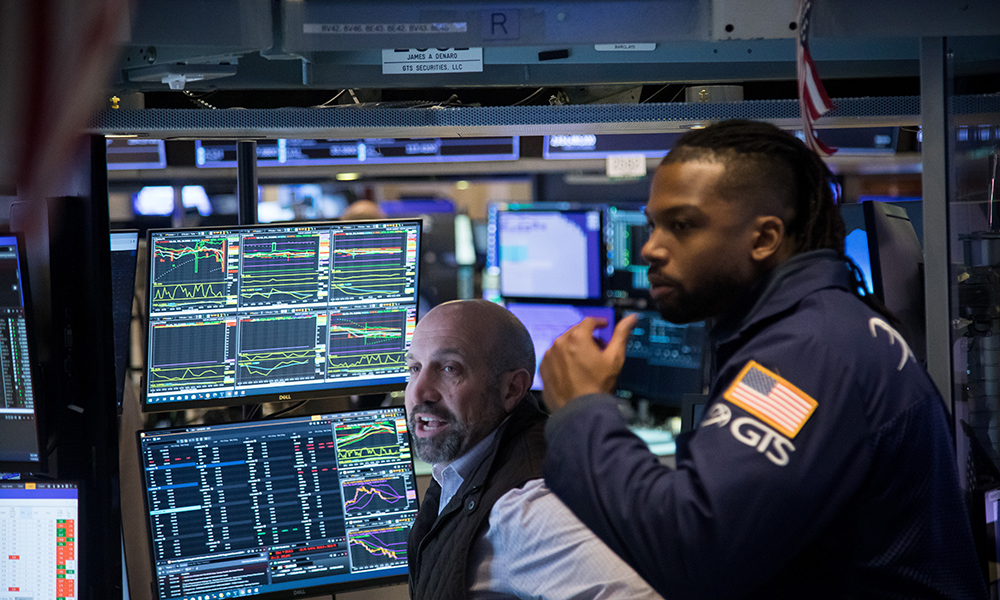
近日有报告显示,美国今年10月的通胀缓解幅度超过预期,受此利好消息影响,美股在11月10日出现了近两年来的单日最大涨幅。
其中,标准普尔500指数(S&P 500)上涨了5.5%,道琼斯工业平均指数(Dow Jones Industrial Average)上涨1,200点,纳斯达克综合指数(Nasdaq Composite)单日飙升7.4%,几乎创下了一整年的涨幅。
随着投资者认为最严重的通胀已经过去,美国证券市场从金属期货到欧洲股票的各种投资品价格都在上涨。不过有分析师提醒道,现在断言恶性通胀已经结束还为时过早。就连前一阵因为信任危机而大跌的比特币(Bitcoin)也收复了部分失地。
最剧烈的波动发生在债券市场。由于投资者对美联储(Federal Reserve)进一步加息控制通胀的预期下降,美国国债的收益率显著下跌。而美联储的大幅加息正是美股市场今年表现惨淡的主要原因,也是有可能让美国经济陷入衰退的一个重要因素。
十年期美债收益率是美国抵押贷款等许多贷款的基准利率,11月10日,十年期美债收益率从4.15%下跌至3.82%。这种下跌对于债券市场是很不寻常的,几乎创下2009年以来的单日最大跌幅。更能代表美联储控制通胀预期的两年期美债收益率也从4.62%下跌至4.32%,有望创下2008年以来的最大跌幅。
11月10日,美股和美债市场的剧烈动荡,主要归功于美国政府的一份报告,该报告显示,美国的通胀率自今年6月探顶以来(9.1%),至今年10月已经连续四个月出现放缓。10月7.7%的通胀率也低于经济学家预测的8%。
更重要的是,在忽略粮食和能源价格后,美国通胀的缓解速度甚至超过了预期。这也是美联储更关注的一个指标。另外,9月和10月的通胀也超过了此前的预期。
Allspring Global Investments公司的高级投资策略师布莱恩·雅各布森指出:“月度环比通胀率所代表的信息更多,按照这个标准衡量,美国的通胀率仍然很高,但并非高得可怕。”
随着通胀率放缓,美联储可能将不再采取特别激进的加息策略。最近一段时间以来,美国已经从今年3月的零利率,加息到了3.75%到4%的区间。
今年夏天,美国的恶性通胀达到近40年来的最高水平。通过大幅加息,美联储有意放慢了经济和就业市场的增长速度,希望以此来降低通胀。但大幅加息的风险在于有可能导致经济衰退。同时加息也会拉低股票和其他投资品的价格。
加息尤其会打击高增长的科技股、数字货币以及其他高风险高价格的投资品。
在这份报告发布后,大型科技股成了华尔街最活跃的股票之一。其中苹果(Apple)报涨8.9%,微软(Microsoft)报涨8.2%,亚马逊(Amazon)报涨12.2%。
以科技股为主的纳斯达克综合指数创下自2020年3月美国新冠疫情爆发以来的单日最高涨幅。而主题较为均衡的标准普尔500指数作为很多401(k)养老基金的最爱,也迎来了自2020年4月以来的单日最高涨幅。
标准普尔500指数上升207.80点,报3,956.37点。道琼斯指数上升1,201.43点,报3,715.37点,涨幅3.7%。纳斯达克指数上升760.97点,报11,114.15点,涨幅达7.4%。
前一段时间,美联储的持续加息使按揭贷款利率达到了整个房地产行业都受到打压的水平。随着市场预期美联储将放宽加息力度,房地产建筑企业和房地产行业的其他公司也出现了强势增长。其中PulteGroup公司上涨13.5%,莱纳公司(Lennar)上涨12.6%,是标准普尔500指数中表现较为抢眼的房地产公司之一。
随着通胀的放缓,美联储有可能会在今年12月的政策会议上下调加息幅度,之前美联储已经连续四次加息0.75个百分点。下一步,美联储有望回归0.25%的小幅加息路径,甚至最终停止加息。
在11月10日的通胀报告发布后,华尔街交易们开始押注下个月美联储将只加息0.5%,而不是更大幅度的加息。
尽管11月10日的通胀数据令人鼓舞,但分析师警告称,美联储遏制通胀的行动可能远未结束。以前的通胀数据也曾经给过人虚假的希望,结果通胀却一再恶化。
摩根士丹利全球投资办公室(Morgan Stanley Global Investment Office)的投资建模主管迈克·勒文加特说:“美联储坚持在通胀放缓前不会停止加息。尽管这次市场反弹说明投资者认为他们已经看到了曙光,但美联储在下次做出加息决定前,还会再收集一次数据。而且要记住,就算我们看到通胀放缓了,物价也仍然处于高位,要恢复正常还有很长一段路要走。”
11月11日发布的另一份报告也有可能震动华尔街,那份报告就是美国家庭对未来几年通胀程度的预期。美联储主席杰罗姆·鲍威尔曾经表示,他特别关注这种预期。
美联储之所以如此热衷于加息,就是因为希望避免出现恶性循环,即高通胀改变了人们的消费方式,而这反过来又导致了更高的通胀。(财富中文网)
译者:朴成奎
近日有报告显示,美国今年10月的通胀缓解幅度超过预期,受此利好消息影响,美股在11月10日出现了近两年来的单日最大涨幅。
其中,标准普尔500指数(S&P 500)上涨了5.5%,道琼斯工业平均指数(Dow Jones Industrial Average)上涨1,200点,纳斯达克综合指数(Nasdaq Composite)单日飙升7.4%,几乎创下了一整年的涨幅。
随着投资者认为最严重的通胀已经过去,美国证券市场从金属期货到欧洲股票的各种投资品价格都在上涨。不过有分析师提醒道,现在断言恶性通胀已经结束还为时过早。就连前一阵因为信任危机而大跌的比特币(Bitcoin)也收复了部分失地。
最剧烈的波动发生在债券市场。由于投资者对美联储(Federal Reserve)进一步加息控制通胀的预期下降,美国国债的收益率显著下跌。而美联储的大幅加息正是美股市场今年表现惨淡的主要原因,也是有可能让美国经济陷入衰退的一个重要因素。
十年期美债收益率是美国抵押贷款等许多贷款的基准利率,11月10日,十年期美债收益率从4.15%下跌至3.82%。这种下跌对于债券市场是很不寻常的,几乎创下2009年以来的单日最大跌幅。更能代表美联储控制通胀预期的两年期美债收益率也从4.62%下跌至4.32%,有望创下2008年以来的最大跌幅。
11月10日,美股和美债市场的剧烈动荡,主要归功于美国政府的一份报告,该报告显示,美国的通胀率自今年6月探顶以来(9.1%),至今年10月已经连续四个月出现放缓。10月7.7%的通胀率也低于经济学家预测的8%。
更重要的是,在忽略粮食和能源价格后,美国通胀的缓解速度甚至超过了预期。这也是美联储更关注的一个指标。另外,9月和10月的通胀也超过了此前的预期。
Allspring Global Investments公司的高级投资策略师布莱恩·雅各布森指出:“月度环比通胀率所代表的信息更多,按照这个标准衡量,美国的通胀率仍然很高,但并非高得可怕。”
随着通胀率放缓,美联储可能将不再采取特别激进的加息策略。最近一段时间以来,美国已经从今年3月的零利率,加息到了3.75%到4%的区间。
今年夏天,美国的恶性通胀达到近40年来的最高水平。通过大幅加息,美联储有意放慢了经济和就业市场的增长速度,希望以此来降低通胀。但大幅加息的风险在于有可能导致经济衰退。同时加息也会拉低股票和其他投资品的价格。
加息尤其会打击高增长的科技股、数字货币以及其他高风险高价格的投资品。
在这份报告发布后,大型科技股成了华尔街最活跃的股票之一。其中苹果(Apple)报涨8.9%,微软(Microsoft)报涨8.2%,亚马逊(Amazon)报涨12.2%。
以科技股为主的纳斯达克综合指数创下自2020年3月美国新冠疫情爆发以来的单日最高涨幅。而主题较为均衡的标准普尔500指数作为很多401(k)养老基金的最爱,也迎来了自2020年4月以来的单日最高涨幅。
标准普尔500指数上升207.80点,报3,956.37点。道琼斯指数上升1,201.43点,报3,715.37点,涨幅3.7%。纳斯达克指数上升760.97点,报11,114.15点,涨幅达7.4%。
前一段时间,美联储的持续加息使按揭贷款利率达到了整个房地产行业都受到打压的水平。随着市场预期美联储将放宽加息力度,房地产建筑企业和房地产行业的其他公司也出现了强势增长。其中PulteGroup公司上涨13.5%,莱纳公司(Lennar)上涨12.6%,是标准普尔500指数中表现较为抢眼的房地产公司之一。
随着通胀的放缓,美联储有可能会在今年12月的政策会议上下调加息幅度,之前美联储已经连续四次加息0.75个百分点。下一步,美联储有望回归0.25%的小幅加息路径,甚至最终停止加息。
在11月10日的通胀报告发布后,华尔街交易们开始押注下个月美联储将只加息0.5%,而不是更大幅度的加息。
尽管11月10日的通胀数据令人鼓舞,但分析师警告称,美联储遏制通胀的行动可能远未结束。以前的通胀数据也曾经给过人虚假的希望,结果通胀却一再恶化。
摩根士丹利全球投资办公室(Morgan Stanley Global Investment Office)的投资建模主管迈克·勒文加特说:“美联储坚持在通胀放缓前不会停止加息。尽管这次市场反弹说明投资者认为他们已经看到了曙光,但美联储在下次做出加息决定前,还会再收集一次数据。而且要记住,就算我们看到通胀放缓了,物价也仍然处于高位,要恢复正常还有很长一段路要走。”
11月11日发布的另一份报告也有可能震动华尔街,那份报告就是美国家庭对未来几年通胀程度的预期。美联储主席杰罗姆·鲍威尔曾经表示,他特别关注这种预期。
美联储之所以如此热衷于加息,就是因为希望避免出现恶性循环,即高通胀改变了人们的消费方式,而这反过来又导致了更高的通胀。(财富中文网)
译者:朴成奎
Wall Street blasted off on November 10 to soar to its best day in more than two years as exhilaration swept through markets after a report showed inflation in the United States eased in October by even more than expected.
The S&P 500 surged 5.5%, while the Dow Jones Industrial Average leaped 1,200 points and the Nasdaq composite packed what could be a year’s worth of gains into one day by roaring 7.4% higher.
Prices jumped for everything from metals to European stocks as investors took the data as a sign that the worst of high inflation may finally have passed, though analysts cautioned it’s still premature to declare that with certainty. Even bitcoin rose to claw back some of its steep plunge from prior days caused by the crypto industry’s latest crisis of confidence.
Some of the most dramatic action was in the bond market, where Treasury yields tumbled sharply as investors pared bets for how aggressive the Federal Reserve will be in hiking interest rates to get inflation under control. Such hikes have been the main reason for Wall Street’s struggles this year and are threatening a recession.
The yield on the 10-year Treasury, which helps set rates for mortgages and other loans, fell to 3.82% from 4.15%. It’s a dramatic move for the bond market, and the yield was on track for its biggest daily drop since 2009, according to Tradeweb. The two-year yield, which more closely tracks expectations for Fed action, fell to 4.32% from 4.62% and was on pace for its sharpest fall since 2008.
All the action stemmed from a U.S. government report showing that inflation slowed in October for a fourth straight month since hitting a peak of 9.1% in June. The reading of 7.7% was better than the 8% economists were expecting.
Perhaps more importantly, inflation also slowed more than expected after ignoring the effects of food and energy prices. That’s the measure the Fed pays closer attention to. So did inflation between September and October.
“The month-on-month rate of inflation is much more informative,” said Brian Jacobsen, senior investment strategist at Allspring Global Investments. “On that measure, inflation is still high, but not scary high.”
Slower inflation could keep the Fed off the most aggressive path in raising interest rates. It’s already raised its key rate to a range of 3.75% to 4%, up from virtually zero in March.
By raising rates, the Fed is intentionally trying to slow the economy and jobs market in hopes of undercutting inflation, which hit a four-decade high in the summer. The risk is that it can create a recession if it goes too far, and higher rates drag down on prices for stocks and other investments in the meantime.
Higher rates have particularly hit high-growth tech stocks, cryptocurrencies and other investments seen as the riskiest or most expensive.
Big Tech stocks were some of the most buoyant forces on Wall Street following the inflation report. Apple rose 8.9%, Microsoft climbed 8.2% and Amazon soared 12.2%.
The Nasdaq composite, which is full of tech-oriented stocks, soared to its best day since March 2020, when Wall Street was in the midst of its frenzied recovery from the crash caused by the coronavirus. The broader S&P 500, which sits at the heart of many 401(k) accounts, had its best day since April 2020.
The S&P 500 climbed 207.80 points to 3,956.37. The Dow gained 1,201.43, or 3.7%, to 33,715.37, and the Nasdaq shot up 760.97, or 7.4%, to 11,114.15.
Homebuilders and other companies in the housing industry were also strong on hopes the Fed will take it easier on rate hikes that have already sent mortgage rates to industry-punishing levels. PulteGroup jumped 13.5%, and Lennar rose 12.6% for some of the bigger gains in the S&P 500.
Slower inflation could get the Federal Reserve to downshift the size of its rate hikes at its next policy meeting in December, after it pushed through four straight mega increases of 0.75 percentage points. That could open the way for the Fed to return to the more typical increases of 0.25 percentage points before pausing hikes completely.
Following November 10’s inflation report, traders increasingly shifted into bets for the Fed to raise rates by only 0.50 percentage points next month, instead of a bigger hike.
While November 10’s report on inflation was encouraging, analysts cautioned the Fed’s campaign against high inflation is likely still far from over. Inflation data has also given false hope before, only to reaccelerate again.
“The Fed was adamant that it won’t hit the brakes on rate hikes until inflation slows, and while the market’s rally indicates investors may see light at the end of the tunnel, it will get one more reading before its decision next month,” said Mike Loewengart, head of model portfolio construction at Morgan Stanley Global Investment Office. “Remember that even as we see a slowdown, prices remain elevated and have a long way to go before normalizing.”
Another potentially market-shaking report will hit Wall Street on November 11, when the latest reading arrives on how much inflation U.S. households see coming in future years. Fed Chair Jerome Powell has said he’s paying particularly close attention to such expectations.
One of the reasons the Fed has been so aggressive about hiking rates is because it wants avoid a debilitating cycle where expectations for high inflation push people to change their behaviors in ways that lead to even higher inflation.






